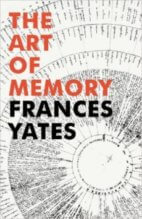A Clean, Well-Lighted Place with Everything Labeled

Many will recall the famous passage from In the Search of Order, where Voegelin analyses Hesiod’s invocation of the Muses and how the Muses “remember” the gods of their divinity.
Memory is an elusive and fascinating topic. How often we wish we had a “better memory “may be witnessed by the number of books, on public library shelves, that offer patent mnemonic strategies for mastering names or grocery lists.
With that in mind, may we “remember” to our readers a book on this topic, that is, on mnemonics, once famous, and still worth attention?
Dr. Frances A. Yates, a scholar of the Renaissance, through being intrigued in the fifties of the last century with Giordano Bruno (1548-1600), came on the “Memory Theatre” of one Guilio Camillo (c. 1480-1544). Having caught her sleeve in the machinery, she was pulled into the subject, and the result, in 1966, was The Art of Memory.
The book is certainly worth honor as a pioneering effort: it is learned down to its toenails, and a pleasure to read–the prose has great panache.
Chapters one and two (of seventeen) discuss the classical systems of memory places, employed chiefly in rhetoric.
Chapter three and four touch on the Middle Ages, and St.Thomas Aquinas. Dr. Yates argues that while the systems and methods stayed the same, the emphasis shifted. Instead of being simply useful systems for recollection, the stress was now on the moral utility of a method for keeping in mind important verities, such as the Last Judgement, and Hell.
Chapter six to fourteen deal with the Renaissance and Giordano Bruno. Now it was the symbols themselves that counted, for Bruno attributed to them occult and hermetic significance. Proper use of his elaborate (very elaborate) visual schemes would open the door to special . . . abilities.
Dr. Yates (chapter fifteen to seventeen) and more controversially) then connects the influence of Bruno with, among other things, the Globe Theatre(!) and the initiation of the scientific method.
Now this is the famous “Yates Paradigm” which was once very influential but is now by not so much so. Nevertheless, one doesn’t have to swallow the whole thesis to see its importance for the history of modern thought. It is of particular interest to those who follow EV in his analysis of ideology as having roots in mystic and occult sources.
For our own part (as to Renaissance studies, we have no dog in the fight) the book has a subtler flaw. Dr. Yates is not very interested in actually trying out these methods. As she forthrightly says:
“There were inert or lazy or unskilled people in Cicero’s time who took the common sense view, to which, personally, I heartily subscribe . . . that all these places and images would only bury under a heap of rubble whatever little one does remember naturally.”
Fair enough. She is a historian of mnemonics, not a practitioner.
But it seems to me that this puts one in the position of a historian of golf who has never had a club in hand or seriously committed his or her life fortune and sacred honour to breaking 110.
Your correspondent has, for some years, worked with these techniques—most recently to try to remember the incipits of the psalms. What can we say? It kills time on streetcars. After diligent use we can report that mnemonics are not a recipe for miracles, but do have utility and moreover an odd charm.
There is a decided pleasure in being able to remember, for example, all the chapter headings of a book, for example the headings of a textbook. The whole of the book, in briefest form, is now in your possession.
Beyond that, there is a certain . . . enlightenment to pressing one’s memory past the usual limits. It is clarifying to learn what sorts of things stick, and what falls away. It induces humility and self-knowledge. Like dieting.
In failing considering the . . . well . . . fun of this sort of thing, Dr. Yates misses, I think, one of the impulses behind their usage over the centuries. People will undertake tasks for a limited external purpose, but what keeps them going through the process is pleasure.
If I may, I would like to return to this topic in a few weeks and discuss another, more recent book on mnemonics that has to a degree superseded Yate’s work, but which would have been impossible without it.




